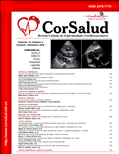Cardiac compaction index calculated in human embryos of Carnegie stages 17-23
Abstract
Introduction: Controversies still persist regarding the events of cardiovascular morphogenesis and an almost total absence of morphometric parameters in the initial phases of its development.
Objectives: To determine the non-compacted to compacted (NC/C) myocardium ratio in both ventricles and the chronological progression of this ratio in the period studied.
Method: A descriptive, cross-sectional study was carried out with 18 human embryos belonging to the Embryoteca of the Universidad de Ciencias Médicas de Villa Clara (Cuba) classified between Carnegie stages 17 and 23. The NC/C ratio —which is simply the mathematical calculation of the ratio between the non-compacted and compacted portions per specimen and per stage— was determined.
Results: The application of this ratio in the right ventricle of the embryos obtained the following results: 7.17; 4.26; 3.12; 2.79; 2.36; 2.84 and 2.10 in Carnegie's stages 17, 18, 19, 20, 21, 22 and 23, respectively. In these same specimens, the left ventricle yielded the following results: 5.0; 3.80; 2.68; 2.18; 2.50; 2.01 and 1.56, also organized by stages.
Conclusions: NC/C ratios obtained quantitatively support a progression of the ventricular myocardial compaction in the evaluated stages; their higher values at the apex denote that it may still be incomplete in this zone.
Downloads
References
1. Marantos Gamarra DG. Análisis descriptivo y morfométrico cardíaco en embriones humanos del estadio 16 de O’Rahilly [Tesis Doctoral]. Madrid: Universidad Complutense de Madrid [Internet]; 2000 [citado 18 Abr 2020]. Disponible en: http://www.ucm.es/BUCM/tesis/19972000/D/0/D0113801.pdf
2. Sadler TW. Sistema cardiovascular. En: Langman. Embriología Médica. 13ª ed. Buenos Aires: Lippincott Williams & Wilkins; 2016. p. 175-191.
3. Paraskevas G, Koutsouflianiotis K, Iliou K. The first descriptions of various anatomical structures and embryological remnants of the heart: A systematic overview. Int J Cardiol. 2017;227:674-90.
4. Carlson BM. Sistema cardiovascular. En: Embriología humana y biología del desarrollo. 5ª ed. Madrid: Ediciones Harcourt; 2014. p. 397-443.
5. Arbustini E, Favalli V, Narula N, Serio A, Grasso M. Left Ventricular Noncompaction: A Distinct Genetic Cardiomyopathy? J Am Coll Cardiol. 2016;68(9):949-66.
6. Moore KL, Persaud TVN, Torchia MG. Embriología clínica. 10ª ed. Barcelona: Elsevier; 2016.
7. Gleason CA, Juul SE. Avery. Enfermedades del Recién Nacido. 10ª ed. Barcelona: Elsevier España; 2019.
8. Pellizzón OA, Gastaldi L, Bonelli JM, Catalano A, Tissera G, Watchsmuth C, et al. Trastornos del ritmo cardiaco en ventrículo izquierdo no compactado aislado. Breve revisión de la literatura a propósito de una casuística. Rev Fed Arg Cardiol. 2015;44(1):57-61.
9. Arbustini E, Weidemann F, Hall JL. Left ventricular noncompaction: a distinct cardiomyopathy or a trait shared by different cardiac diseases? J Am Coll Cardiol. 2014;64(17):1840-50.
10. Luxán G, D’Amato G, de la Pompa JL. Intercellular Signaling in Cardiac Development and Disease: The NOTCH pathway. En: Nakanishi T, Markwald RR, Baldwin HS, Keller BB, Srivastava D, Yamagishi H, eds. Etiology and Morphogenesis of Congenital Heart Disease: From Gene Function and Cellular Interaction to Morphology. Tokyo: Springer; 2016. p. 103-14.
11. Núñez-Patiño R, Yepes N, Solorza-Kasperson M, Moreno F. Cardiogénesis: Bases estructurales y moleculares a partir del modelo de rata Wistar. Salutem Scientia Spiritus [Internet]. 2017 [citado 18 Abr 2020];3(1):37-45. Disponible en: https://revistas.javerianacali.edu.co/index.php/salutemscientiaspiritus/article/view/1679/pdf
12. Bernstein D. Desarrollo del corazón. En: Kliegman RM, Stanton B, St. Geme JW, Schor NF, eds. Nelson. Tratado de Pediatría. 20ª ed. Barcelona: Elsevier; 2016. p. 2258-62.
13. Towbin JA, Ballweg J, Johnson J. Left ventricular noncompaction cardiomyopathy. En: Jefferies JL, Chang AC, Rossano JW, Shaddy RE, Towbin JA, eds. Heart Failure in the Child and Young Adult: From Bench to Bedside. London: Elsevier; 2018. p. 269-90.
14. Brainerd Arey L. Anatomía del desarrollo. 3ª ed. La Habana: Editorial Pueblo y Educación; 1975.
15. Hill MA. Embryology: Embryonic Development. Sydney: The University of New South Wales [Internet]; 2020 [citado 22 Abr 2020]. Disponible en: https://embryology.med.unsw.edu.au/embryology/index.php/Embryonic_Development
16. Jerez Castro AM, Echevarría Poymiró S, Guevara Mirabal G, Aleaga Castro E. Miocardiopatía por ventrículo no compactado. Acerca de evolución histórica, definiciones y generalidades del tema. Rev Cuban Cardiol [Internet]. 2015 [citado 27 Abr 2020];21(2):117-22. Disponible en: http://www.revcardiologia.sld.cu/index.php/revcardiologia/article/view/586/pdf_11
17. Catalán, P, Salinas A, Barettino D. Ventrículo izquierdo hipertrabeculado o no compactado: ¿son necesarios nuevos criterios diagnósticos? Rev Esp Cardiol. 2010;63(4):472.
18. Mérida Álvarez O, Valdés García M, Castro Arca AM, Prohías Martínez J, Sotto García Z. Dilemas actuales en el diagnóstico del ventrículo izquierdo no compacto. Rev Fed Arg Cardiol [Internet]. 2013 [citado 30 Abr 2020];42(4). Disponible en: https://www.fac.org.ar/archivo/1/revista/13v42n4/art_revis/revis02/alvarez.php
19. Dorantes Sánchez M, Jerez Castro AM. Hechavarría Poymiró S. Ventrículo izquierdo no compacto: panorámica y arritmogenia. CorSalud [Internet]. 2018 [citado 30 Abr 2020];10(1):52-62. Disponible en: http://www.revcorsalud.sld.cu/index.php/cors/article/view/292/626
20. Steffel J, Kobza R, Oechslin E, Jenni R, Duru F. Electrocardiographic characteristics at initial diagnosis in patients with isolated left ventricular noncompaction. Am J Cardiol. 2009;104(7):984-9.
21. Weir-McCall JR, Yeap PM, Papagiorcopulo C, Fitzgerald K, Gandy SJ, Lambert M, et al. Left ventricular noncompaction: Anatomical phenotype or distinct cardiomyopathy? J Am Coll Cardiol. 2016;68(20):2157-65.
Downloads
Published
How to Cite
Issue
Section
License
Authors who publish with this journal agree to the following terms:- Authors retain copyright and grant the journal right of first publication with the work simultaneously licensed under a Creative Commons Attribution License that allows others to share the work with an acknowledgement of the work's authorship and initial publication in this journal.
- Authors are able to enter into separate, additional contractual arrangements for the non-exclusive distribution of the journal's published version of the work (e.g., post it to an institutional repository or publish it in a book), with an acknowledgement of its initial publication in this journal.










